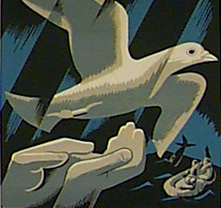Second World War
Commercial Film Distribution and the War
When the Second World War broke out on 3 September 1939, no one doubted that it would have a great impact on every aspect of film activity in Quebec.
Because Hollywood was not at first directly affected by the war, English-language movie theatres in Quebec continued merrily along and never lacked for films. What’s more, the war soon supplied them with a surfeit of dramatic topics. Before long, these were the only theatres advertising in the pages of the province’s daily newspapers.
In the French-language film distribution sector, J.A. DeSève initially expressed a degree of optimism, declaring that “France-Film has a store of films that will last at least two years”. But two years flew by quickly and shortages became the norm. No one thought the war would last six long years.
In December 1941, France-Film was obliged to sell the Beaubien cinema, the jewel in the crown of its neighbourhood cinemas, which opened in 1937. At the same time, it also sold its Montreal Cinéma de Paris. The other Cinéma de Paris theatres, in Trois-Rivières, Sherbrooke and Quebec City, remained open, but were soon only showing reruns or putting on live entertainment.
The Théâtre Saint-Denis, the chain’s flagship theatre in Montreal, began to diversify its offerings in 1942. Many films were still shown there, but they were mostly 1930s reruns, sometimes in a slightly different version. The Saint-Denis also put on many stage plays with local theatre companies supplemented by refugees from France. Each year New York’s famous Metropolitan opera performed there for a week. Major international musicians such as Fritz Kreisler and Witold Malcuzinski appeared there with the Montreal Philharmonic Orchestra. In 1944, the Saint-Denis hosted the Ballets Russes, something that would have been unthinkable if the Soviet Union had not become a Canadian ally.
War-time Production
The National Film Board was not yet organised. Its mandate was temporarily redefined in order for it to become an important source of information for the Canadian public about the war.
In 1940 the series “Canada Carries On” was inaugurated. At a rate of one short film per month, the series informed the population about the war’s progress and aimed to “keep up Canadians’ morale”. People saw how life was organised around wartime production in every part of the country and how every citizen was contributing to the collective effort. One of these films, Churchill’s Island (1941), was the first NFB film to win an Academy Award. The series continued on until the late 1950s, examining subjects other than the war.
In September 1941, a second series, “Actualités canadiennes” (whose name was changed in 1943 to “Les Reportages”), examined a wide range of current events. The series was produced for French-speaking audiences and was headed by Vincent Paquette. It showed everything from the training of soldiers to the centenary of the village of Grande-Vallée to tobacco cultivation in Joliette.
Another series, “The World in Action”, was inaugurated in 1942. It showed images of the war and sought to explain international affairs. Claiming that they had communist sympathies, the Bureau de censure du Québec banned two of these films, Inside Fighting Russia and Our Northern Neighbour. The series was also sold abroad, particularly in Great Britain and the United States; in the latter country, the NFB had an agreement with the famous producer of the March of Time newsreels.
Widely Seen Films
NFB films were distributed throughout Canada in various ways. France-Film added short films to its programs in commercial French-speaking movie theatres, and Famous Players did the same in its English-speaking theatres. Where there were no commercial theatres, NFB projectionists travelled around the countryside with film prints, showing them wherever they could: parish halls, schools, social clubs, etc. There were even lunch-time screenings in factories.
Viewers from this period recount that they often went to the cinema mostly to see these informative films. Citizens everywhere were eager to see moving pictures about the war. In the countryside, these screenings were sometimes the first contact people had with cinema.
